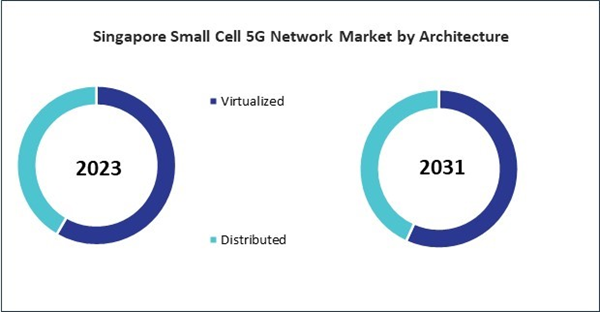The China market dominated the Asia Pacific Small Cell 5G Network Market by country in 2023, and is expected to continue to be a dominant market till 2031; thereby, achieving a market value of $11.25 billion by 2031. The Japan market is registering a CAGR of 50.5% during 2024-2031. Additionally, the India market is expected to showcase a CAGR of 52.4% during 2024-2031.
The small cell 5G network market is driven by several factors, each adding complexity and opportunity to the telecommunications ecosystem. First, a large percentage of the world's population is moving into cities, which is an inevitable drive towards urbanization. Moreover, the proliferation of Internet of Things (IoT) devices and the escalating demand for mobile data underscore the need for a more robust network infrastructure.
Moreover, small cells reduce latency and improve service quality by offloading data traffic from more extensive networks, making them an essential component of modern network architecture, particularly as industries lean more heavily on real-time data processing and machine-to-machine communications.
The Asia Pacific region is experiencing a swift proliferation of small cell 5G networks, propelled by a variety of demands that encompass enhancements in urban connectivity as well as the optimization of infrastructure within expansive smart cities. China's commitment to establishing itself as a global leader in 5G technology is evident in its extensive deployment of small cells across multiple cities, significantly supported by government initiatives such as the "New Infrastructure" plan. This national strategy not only focuses on expanding digital infrastructure but also heavily emphasizes the development of smart cities using 5G technologies.
List of Key Companies Profiled
- Huawei Technologies Co., Ltd. (Huawei Investment & Holding Co., Ltd.)
- Samsung Electronics Co., Ltd. (Samsung Group)
- Nokia Corporation
- Ericsson AB
- ZTE Corporation
- CommScope Holding Company, Inc.
- Fujitsu Limited
- Airspan Networks Holdings Inc.
- Verizon Communications, Inc.
- Vodafone Group Plc
Market Report Segmentation
By Component- Hardware
- Microcell
- Picocell
- Femtocell
- Services
- Consulting
- Deployment & Integration
- Training and Support & Maintenance
- Non-standalone
- Standalone
- Sub-6 GHz
- mmWave
- Sub-6GHz + mmWave
- Virtualized
- Distributed
- Indoor
- Outdoor
- Commercial
- Industrial
- Residential
- Smart City
- Transportation & Logistics
- Government & Defense
- Other End-use
- China
- Japan
- India
- South Korea
- Singapore
- Malaysia
- Rest of Asia Pacific
Table of Contents
Companies Mentioned
- Huawei Technologies Co., Ltd. (Huawei Investment & Holding Co., Ltd.)
- Samsung Electronics Co., Ltd. (Samsung Group)
- Nokia Corporation
- Ericsson AB
- ZTE Corporation
- CommScope Holding Company, Inc.
- Fujitsu Limited
- Airspan Networks Holdings Inc.
- Verizon Communications, Inc.
- Vodafone Group Plc
Methodology

LOADING...









